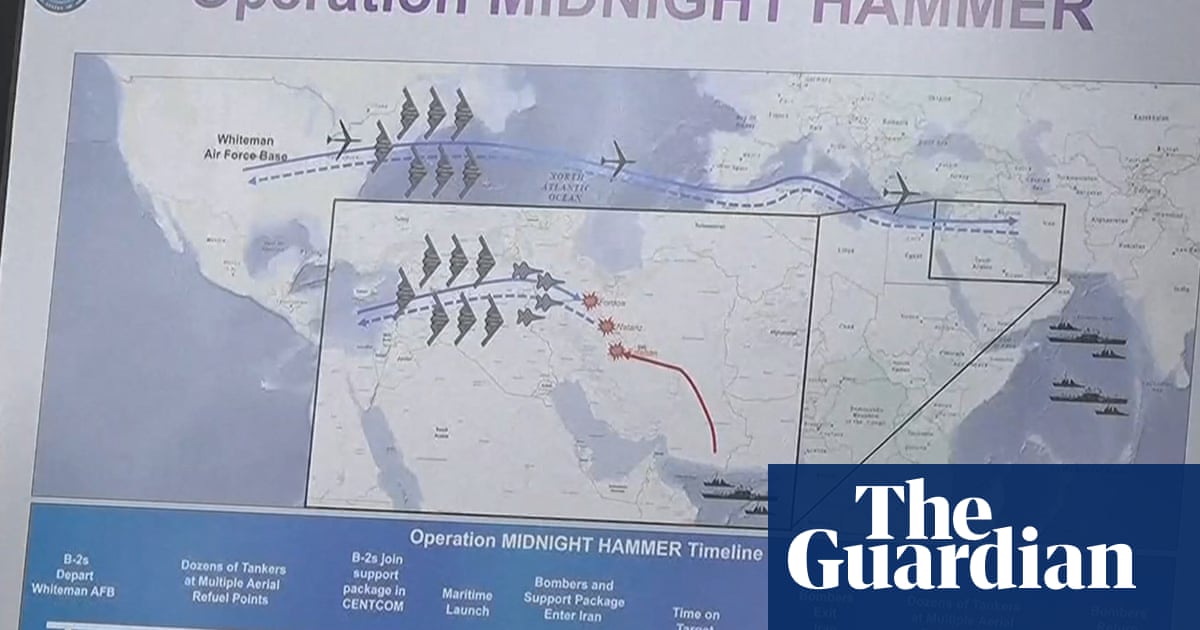Donald Trump was quick to claim that US strikes on Iran’s nuclear facilities had “completely and totally obliterated” them. Still, it remains unclear how much physical damage has been done or what the longer-term impact might be on Iran’s nuclear programme.
The Atomic Energy Organization of Iran (AEOI) confirmed that attacks took place on its Fordow, Isfahan and Natanz sites, but insisted that its nuclear programme would not be stopped. Both Iran and the UN nuclear watchdog said there were no immediate signs of radioactive contamination around the three locations after the strikes.
The Iranian Red Crescent also reported no deaths in the US strikes on the nuclear sites, appearing to confirm Iranian claims they had been evacuated in advance. In the immediate aftermath,US militaryofficials suggested the three sites had suffered “severe damage” after an operation that had been weeks in planning, suggesting that it was fully coordinated in advance with Israel.
The Pentagon said a battle damage assessment was still being conducted.
Long regarded as the most difficult military target among Iran’s nuclear sites, the uranium enrichment facilities at Fordow – the primary target of the operation – are buried beneath the Zagros mountains. Reports have suggested that the site was constructed beneath between 45 and 90 metres of bedrock, largely limestone and dolomite.
Some experts have suggested that the layering of the sedimentary rocks, including faults, would also make it more difficult to strike the centrifuge array, providing a kind of geological cushioning against a blast wave.
The attack – codenamed Operation Midnight Hammer – was carried out by seven B-2 Spirit stealth bombers flying from the US, after a deception flight by other B-2s into the Pacific. Tomahawk missiles were also fired from US ships in waters south of Iran.
The site was hit by a dozen 13,600kg massive ordnance penetrators – known as bunker busters – at around 2.10am Iranian time. It was the massive weapon’s first operational use. The number used suggests some lack of confidence that a smaller strike could penetrate to the target.
The result would to a large extent depend on the kind of concrete inside the facility, with estimates of the bunker busters’ penetration based largely on reinforced concrete resistant to 5,000psi. Iran is believed to have used more resistant concrete.
While video from the site showed evidence of a fire in the immediate aftermath, satellite images published on Sunday were inconclusive.
The Open Source Centre in London highlighted what appeared to be at least two locations where the weapons appeared to have penetrated.
While the main support building at the site appeared to be undamaged, the topography of a prominent area of ridgelines and small wadis appeared to have altered and been flattened out, with some evidence of rock scarring exposing damaged bedrock near an area that could show fresh cratering.
While analysts had previously suggested that a strike could hit the main entrance tunnel to the site, the main effort appears to have been in a different location.
There was speculation that the main aim of the strikes may have been to bury access to Fordow.
Isfahan’s nuclear technology centre was struck by cruise missiles as opposed to bunker busters. Video posted on social media showed a distant detonation from the site on Saturday night.
According to the International Atomic Energy Agency (IAEA), in addition to four hit by Israeli strikes, six other buildings had now been attacked, including a fuel rod production facility.
The IAEA said facilities targeted at Isfahan either contained no nuclear material or small quantities of natural or low-enriched uranium.
Natanz had previously been damaged by the first Israeli strikes of the conflict, with assessments then suggesting they had hit the power plant supplying the main centrifuge hall. Uranium had been enriched to up to 60%, short of weapons-grade material.
It appears that Natanz’s underground enrichment hall was targeted, but it is unclear how much damage was inflicted.
In response to the US strikes, Iran launched ballistic missiles at Israel on Sunday, triggering countrywide air raid sirens and injuring 16 people.
Iran has claimed that it evacuated the sites several days ago, and satellite imagery from several days ago suggests there was unusual truck traffic at Fordow. That appears to confirm the movement of some material from the site, possibly including the uranium stockpile – or parts of it – which remains unaccounted for.
Hassan Abedini, the deputy political head of Iran’s state broadcaster, said Iran had evacuated the three sites – Natanz, Isfahan and Fordow – some time ago.
“The enriched uranium reserves had been transferred from the nuclear centres and there are no materials left there that, if targeted, would cause radiation and be harmful to our compatriots,” he said.
Three days before the US attacks, 16 cargo trucks were seen near the Fordow entrance tunnel.
The head of the AEOI, Mohammad Eslami, claimed this month that Iran had another enrichment site “in a secure and invulnerable location” where centrifuges could be.
Analysts have long argued that while it is possible to disrupt the physical function of a nuclear facility and limit the scope of a programme through, for example, the Israeli assassination of scientists, the breadth of technical knowledge acquired during the decades-long programme is impossible to destroy.
Ultimately, the question is whether the US-Israeli attacks are seen as sufficient for Iran to capitulate, or whether they instead encourage the regime to accelerate its efforts to produce a viable nuclear weapon.
